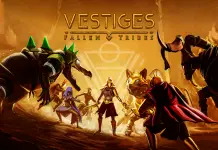To answer the question posed in the title for this new escape room puzzler, the answer is unequivocally “yes!” There wouldn’t be much of a premise to latch onto if that wasn’t the case.
You awaken in a small cabin room littered with various knick-knacks that appear to relate to typical video game puzzles. The only door in the room is jumbled up, mosaic tiles litter the floor, a grid is partly illuminated with lights, and the clock’s face features not numbers but symbols. It doesn’t take long to learn what’s going on, with a dead-eyed wizard bursting through the window as soon as you awaken. To escape this arbitrarily decorated abode, you need to play a pixel art video game set in an eerie candlelit castle.
This isn’t any video game – it has the power to alter the real world, and vice versa. The aforementioned jumbled door? That can be unscrambled by playing a tile sliding puzzle. This is just the tip of the iceberg, as it isn’t long until puzzles become far more elaborate, requiring out-of-the-box thinking to resolve. You’re going to be spending just as much time in the cabin, with its handful of interactable objects, as you are in the faux 16-bit style video game. Some puzzles even involve playing the game, exiting into the real world to tinker with something, before going back into the digital world. A good example: draining a pool of blood in the virtual game by connecting pipes and turning on the tap in the cabin’s kitchen. Another puzzle entails placing bulbs into a wall-mounted grid to light a safe path in the video game.
Over time more cabin rooms open, eventually leading into the basement, and shortcuts can be created by tearing down walls. Every room has a monitor that features a real-time image of the video game; these aren’t interactable, yet can be useful if a solution is currently onscreen.

If you die in the video game, say by flicking a switch without solving a puzzle first, you’ll die in the cabin – usually by having an arrow fired out of the wall, or falling into a vat of acid.
Boss fights are another feature, all of which use a non-traditional format of avoiding hazards before collecting the appropriate symbols – such as fire, ice and poison. Adding further variety, there’s a short fishing mini-game which ties into the introduction of an item vendor. Just to hammer home how creative the experience becomes, said vendor can be tricked by altering the price fish sell for – allowing you to clear out their entire inventory and progress.
There’s a hint system for those who become truly stuck, which grants a small hint first before giving away part of the solution – if not the whole solution. The developers have been savvy with how much information should be divulged. In fact, the whole thing is well presented, using a chunky glamorised PS1-style aesthetic and detailed pixel art. There are a couple of other characters to talk to, helping to induce a sense of personality, and while the dialogue is basic, it’s also clear and concise. It can even be an atmospheric experience at times.

Is this Game Trying to Kill Me? turned out to be a pleasant surprise thanks to its creative puzzles and innovative dual-world set-up that sees the two locations cleverly intertwined. We’ve seen similar puzzle types before – such as lighting candles in a certain order, matching symbols, and performing a ritual using a guidebook – but everything here is handled with an air of confidence, and there are some subtle twists present. I can’t vouch for how taxing you’ll find it – everyone’s level of intelligence differs, after all – but I feel that a few puzzles will have you stumped, and you may have to use the occasional hint.
Initially, I had this pegged as a short experience, lasting two hours at the most, but my playtime was closer to four – with one puzzle leaving me flummoxed for a good twenty minutes. It has multiple endings to discover, with one adding another thirty minutes of playtime, broadening the lore in the process. Some players may overlook one of the endings entirely, requiring a few extra steps to see through to the conclusion.
This is an easy recommendation to puzzle game fans, offering something new and refined. Looking at the developer’s past works, it seems to be a culmination of all their previous fantasy and puzzle adventures, in the sense that the expertise and knowledge discovered there has led to this. The only major criticism, other than the final set of puzzles feeling weaker than those before it, is the £17 (approx.) price tag. Once you’ve figured out how to get the ‘good’ ending, there’s no reason to return, meaning there is a risk that you may feel shortchanged. Puzzle game diehards can at least offset that risk by knowing that they’re in for a good, if brief, time here. Even retro fans may want to get in on the action, and that’s despite it not being influenced by any particular classic.
Stately Snail’s Is this Game Trying to Kill Me?is out 4th April on consoles. Published by Sometimes You. A PC version is also available.

































